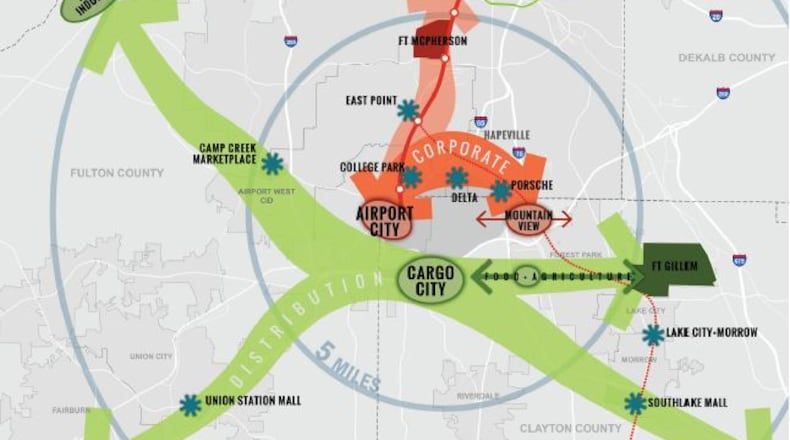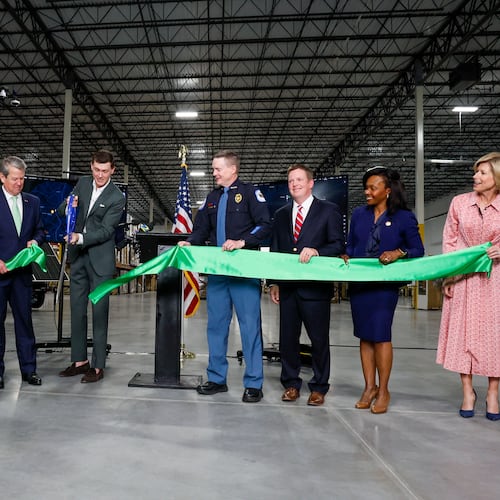A new blueprint aims to lay out a vision to transform the region surrounding Hartsfield-Jackson International Airport into an “aerotropolis” with a corporate crescent, an “airport city” and a green corridor of trails.
The idea is to attract more businesses to the airport area, to create more jobs on the Southside and to eventually make the aerotropolis into a thriving business district.
The 114-page document lays out the type of development the Aerotropolis Atlanta Alliance would like to see. It targets catalyst areas including a "cargo city" to the south of the airport and an "international gateway" area east of the international terminal that could drive more development within 10 miles of the airport in coming years and decades.
“Our airport is a central business district,” like downtown, Midtown and Buckhead, said Aerotropolis Atlanta vice-chair Kevin Johnson. Planners envision an area with corporate headquarters, attractions and “hip” places for young professionals to live.
Also anchoring the aerotropolis are the historic downtowns of East Point, College Park and Hapeville, according to the report. The “aerotropolis” in question covers an area of 165 square miles, two counties and 10 cities, with a population of 297,630 people.
The ideas in the report — which was prepared for $220,000 by a team led by consulting firm Jacobs for the Atlanta Regional Commission and the Aerotropolis Atlanta Alliance — are not necessarily specific projects planned for development. Instead, the report is aimed at helping to “reset the conversation in the airport area,” said Atlanta Regional Commission planner Jon Tuley.
"We have some good things going on," including the Porsche headquarters opened next to the airport last year and the Gateway Center development west of the airport, Tuley said. "But there wasn't an overall vision that brought things together."
Long runway ahead
Don’t expect to see everything laid out in the blueprint come to fruition. The area that makes up the aerotropolis has long faced challenges in spurring development. And real transformation of the area could take decades.
The blueprint contemplates an “incubation” of five years and a “take off” period of five to ten years.
And the time frame for “significant change” would be in the 20- to 25-year range, according to Johnson, who is also senior vice president of economic development for Invest Atlanta, the economic development arm for the city of Atlanta.
Who will pay for it? That’s yet to be seen.
One of the key goals of the aerotropolis is for the many local governments that dot the area to work together to attract companies and development, according to the report.
Separately, aerotropolis community improvement districts have been working on beautification, road improvements, better signs and public safety.
Southside lagging
Driving the push for a plan to develop the aerotropolis has been the lag of development on the Southside.
“Over the past several years, many economic development wins and investments have occurred in communities to the north, particularly north of downtown Atlanta and within northern suburbs,” the report notes. “It is fair to say that the area south of I-20 has not shared equally in those benefits.”
The report also calls the airport both the area’s “greatest asset and challenge,” noting that the aerotropolis area has “experienced ups and downs since the airport developed.”
Along with longstanding concerns about aircraft noise, pollution and other issues around the airport, the report also notes that the use of land in areas close to the airport are subject to local regulations as well as Federal Aviation Administration restrictions. Some areas next to the airport have housing vacancy rates of 20 percent or higher. And the airport's expansion has led to some neighborhoods being cleared out, such as the Mountain View area to the east of the airport.
That area and parts of College Park “have become unsuitable for living as a result of flight patterns and FAA regulations,” the report notes. So residential areas are often next to industrial areas, and the airport’s plans to build a sixth runway could affect even more homes.
“Living within the aerotropolis has its benefits and drawbacks,” the report says.
Work in the aerotropolis
Some who live in areas near the airport are optimistic about what development could bring.
“We’re on the cusp of something really big happening,” said College Park resident Sandy Causey.
The hope is that the aerotropolis — bolstered by the Porsche headquarters and a planned hotel and commercial development next to the airport's domestic terminal — could attract more white-collar and professional jobs, rather than just the aviation and industrial sectors it has long been known for.
In a separate study, Hartsfield-Jackson determined that the total economic impact of the airport was $64.3 billion in 2013, driving more than 448,000 jobs in the region directly or indirectly, including everyone from taxi drivers to hotel and restaurant workers whose businesses benefit from the influx of travelers.
But about 85 percent of those who work in the aerotropolis area commute from elsewhere, with many choosing areas like Peachtree City or the northside of metro Atlanta. The blueprint cited opportunities to increase the availability of housing that appeals to young professionals who work in the airport area.
Andrew Nelson, an East Point resident, thinks in order to retain residents, public schools need to improve, noting that some of his neighbors moved to East Point but moved out when their kids reached school age.
One focus of the report is improving quality of life. An idea floated in the report is to revive the Flint River Basin to create a green corridor of trails guided by streams and parks. Also proposed is a “circulator bus” for tourists and airport area workers in the Hapeville, College Park and East Point areas.
Beyond the Atlanta aerotropolis
Johnson thinks development of the airport area could benefit metro Atlanta as a whole. “I can’t think of a part of the metropolitan Atlanta region where there isn’t a vein from the airport,” Johnson said.
The model for an aerotropolis that many planners point to is Amsterdam’s Schiphol Airport, which has 500 companies on airport grounds and European headquarters of companies like Microsoft and Prologis located at Schiphol.
The report also recommends drawing on tourist sites and potential tourism attractions, including the Delta Flight Museum, Chick-fil-A headquarters, the Porsche Experience Center, tours of movie studios in the area, and historic Jonesboro, College Park, East Point and Hapeville.
“The Aerotropolis has several opportunities to leverage and promote its ‘coolness factor’ to the greater world,” the report contends.
The blueprint also includes recommendations to audit local land use policies, set a single point of contact to coordinate zoning and permitting and to develop a detailed master plan for key sites.
Other entities, such as chambers of commerce, businesses, the hodge-podge of governments that surround the airport and the aerotropolis community improvement districts, can look to the blueprint as they make plans for future development, according to Tuley.
Major headquarters in the Atlanta Aerotropolis
Delta Air Lines
Chick-fil-A
Porsche Cars North America
Attractions in the aerotropolis area
Delta Flight Museum
Chick-fil-A headquarters tour
Porsche Experience Center
What is the Aerotropolis Atlanta Alliance?
The Aerotropolis Atlanta Alliance is a non-profit coalition of businesses and government representatives in the aerotropolis area. The board of directors includes representatives from:
- Chick-fil-A Foundation, Delta Air Lines, Duke Realty, Georgia Power, Porsche Cars North America, SunTrust Bank and other businesses
- Cities of Atlanta, College Park, East Point, Forest Park and Hapeville, as well as Clayton County and Fulton County
- Metro Atlanta Chamber, South Fulton Chamber, Clayton County Chamber and Airport Area Chamber of Commerce, and Atlanta Aerotropolis community improvement districts
About the Author
Keep Reading
The Latest
Featured




